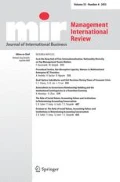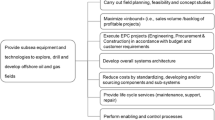Abstract
It is difficult to make large, complex organizations like MNCs ambidextrous—to make them efficient so that they succeed in the short run and in sync with their changing environments so that they succeed and survive in the long run. The two types of learning activity that support ambidexterity, exploitation and exploration, are fundamentally different (March 1991). The well-known structural approach to creating organizational ambidexterity employs separate subunits for exploitation and exploration (O’Reilly and Tushman 2011). We argue that this approach cannot take full advantage of the high levels of product, geographic, and functional diversity that exist in large, complex firms to create ambidexterity at a more macro level. Firms facing this kind of complexity often address it by using a matrix structure. For such firms, we argue that a more flexible form of matrix structure can facilitate the creation of a new form of ambidexterity at the macro level of such firms. As developed in Egelhoff and Wolf (Egelhoff and Wolf 2017), a flexible matrix structure is one which can vary its mode of decision making between balanced decision making, where decisions are jointly made by both dimensions of a matrix, and rule-based decision making, where it is pre-specified which dimension of a matrix will unilaterally make certain types of decision. We argue that rule-based decision making tends to facilitate exploitation and the refinement of existing knowledge while balanced decision making tends to facilitate exploration and the development of new knowledge. By specifying one mode of decision making or the other, firm-level management can deliberately steer important strategic decisions (e.g., new product technology development) into either exploitation or exploration and strategy renewal, creating a new form of ambidexterity at the macro level.

Similar content being viewed by others
Notes
As developed by Nickerson and Zenger (2002), Siggelkow and Levinthal (2003), and Boumgarden et al. (2012), the sequential or temporal approach to ambidexterity describes a firm randomly vacillating between a decentralized organization design (which facilitates local exploration at the business unit level) and a centralized organization design (which facilitates exploitation and efficiency by providing more coordination across the business units). Our definition of ambidexterity, which requires the emphasis on exploration or exploitation to rationally vary within a firm by strategy, is clearly not consistent with the sequential approach, where an entire firm and all of its strategies randomly vacillate in unison between exploitation and exploration. As a result, this approach will not be discussed.
References
Adler, P., Goldoftas, B., & Levine, D. (1999). Flexibility versus efficiency? A case study of model changeovers in the Toyota production system. Organization Science,10(1), 43–68.
Boumgarden, P., Nickerson, J., & Zenger, T. (2012). Sailing into the wind: Exploring the relationship among ambidexterity, vacillation, and organizational performance. Strategic Management Journal,33(6), 587–610.
Burgelman, R. A. (1983). A model of the interaction of strategic behavior, corporate context, and the concept of strategy. Academy of Management Review,3(1), 61–70.
Burgelman, R. A. (1991). Intraorganizational ecology of strategy making and organizational adaptation: Theory and field research. Organization Science,2(3), 239–262.
Burgelman, R. A. (2002). Strategy is destiny: How strategy-making shapes a company’s future. New York: Free Press.
Ciabuschi, F., Forsgren, M., & Martin Martin, O. (2011). Rationality versus ignorance: The role of the MNE headquarters in subsidiaries’ innovation processes. Journal of International Business Studies,42, 958–970.
Ciabuschi, F., Forsgren, M., & Martin Martin, O. (2012). Headquarters involvement and efficiency of innovation development and transfer in multinationals: A matter of sheer ignorance? International Business Review,21(2), 130–144.
Davis, S. M., & Lawrence, P. R. (1977). Matrix. Reading: Addison-Wesley.
Donaldson, L. (2009). In search of the matrix advantage: A re-examination of the fit of matrix structures to transnational strategy. In J. Cheng, E. Maitland & S. Nicholas (Eds.), Managing subsidiary dynamics: Headquarters role, capability development, and China strategy, Advances in international management series (pp. 3–26). Emerald Publishing: Bingley.
Dougherty, D. (1992). Interpretive barriers to successful product innovation in large firms. Organization Science,3(2), 179–202.
Egelhoff, W. G. (1982). Strategy and structure in multinational corporations: An information-processing approach. Administrative Science Quarterly,27(3), 435–458.
Egelhoff, W. G. (1991). Information-processing theory and the multinational enterprise. Journal of International Business Studies,22(3), 341–358.
Egelhoff, W. G., & Wolf, J. (2017). Understanding Matrix Structures and their Alternatives: The key to designing and managing large, complex organizations. London: Palgrave Macmillan.
Egelhoff, W. G., Wolf, J., & Adzic, M. (2013). Designing matrix structures to fit MNC strategy. Global Strategy Journal,3(3), 205–226.
Forsgren, M., & Holm, U. (2010). MNC headquarters’ role in subsidiaries’ value-creating activities: A problem of rationality or radical uncertainty. Scandinavian Journal of Management,26(4), 421–430.
Forsgren, M., Holm, U., & Johanson, J. (2005). Managing the embedded multinationsl: A business network view. Cheltenham: Edward Elgar Publishing.
Galbraith, J. R. (1973). Designing complex organizations. Reading: Addison-Wesley.
Galbraith, J. R. (2009). Designing matrix organizations that actually work. San Francisco: Jossey-Bass.
Gibson, C. B., & Birkinshaw, J. (2004). The antecedents, consequences, and mediating role of organizational ambidexterity. Academy of Management Journal,47(2), 209–226.
Goossen, M. E. (1978). Calfornia Bank’s personal finance group. Harvard Business School Case,9, 478–555.
Gupta, A. K., Smith, K. G., & Shalley, C. E. (2006). The interplay between exploration and exploitation. Academy of Management Journal,4, 693–706.
He, Z. L., & Wong, P. K. (2004). Exploration vs exploitation: An empirical test of the ambidexterity hypothesis. Organization Science,15(4), 481–494.
Jansen, J. J. P., Tempelaar, M., van den Bosch, F. A. J., & Volberda, H. (2009). Structural differentiation and ambidexterity: The mediating role of integration mechanisms. Organization Science,20(4), 797–811.
Katila, R., & Ahuja, G. (2002). Something old, something new: A longitudinal study of search behavior and new product introduction. Academy of Management Journal,45(6), 1183–1194.
March, J. G. (1991). Exploration and exploitation in organizational learning. Organization Science,2(1), 71–87.
Mintzberg, H. (1979). The structuring of organizations. Englewood Cliffs: Prentice-Hall.
Nickerson, J. A., & Zenger, T. R. (2002). Being efficiently fickle: A dynamic theory of organizational choice. Organization Science,13(5), 547–566.
O’Reilly, C. A., Harreld, J. B., & Tushman, M. (2009). Organizational ambidexterity: IBM and emerging business opportunities. California Management Review,51(4), 1–25.
O’Reilly, C. A., & Tushman, M. L. (2004). The ambidextrous organization. Harvard Business Review,20, 74–83.
O’Reilly, C. A., & Tushman, M. L. (2008). Ambidexterity as a dynamic capability: Resolving the innovator’s dilemma. Research in Organizational Behavior,28, 185–206.
O’Reilly, C. A., & Tushman, M. L. (2011). Organizational ambidexterity in action: How managers explore and exploit. California Management Review,53(4), 5–21.
O’Reilly, C. A., & Tushman, M. L. (2013). Organizational ambidexterity: Past, present and future. Academy of Management Perspectives,27(4), 324–338.
Peters, T. J., & Waterman, R. U., Jr. (1982). In search of excellence: Lessons from America’s best-run companies. New York: Warner.
Pitts, R. A., & Daniels, J. D. (1984). Aftermath of the matrix mania. Columbia Journal of World Business,19(2), 48–54.
Qui, J. X., & Donaldson, L. (2010). The cubic contingency model: Towards a more comprehensive international strategy-structure model. Journal of General Management,36(1), 81–100.
Raisch, S., & Birkinshaw, J. (2008). Organizational ambidexterity: Antecedents, outcomes, and moderators. Journal of Management,34(3), 375–409.
Siggelkow, N., & Levinthal, D. A. (2003). Temporarily divide to conquer: Centralized, decentralized, and reintegrated organizational approaches to exploration and adaptation. Organization Science,14(6), 650–669.
Smith, W., Binns, A., & Tushman, M. (2010). Complex business models: Managing strategic paradoxes simultaneously. Long Range Planning,43(2–3), 448–461.
Tushman, M. L., & Nadler, D. A. (1978). Information processing as an integrating concept in organizational design. Academy of Management Review,3(3), 613–624.
Tushman, M. L., & O’Reilly, C. A. (1996). Ambidextrous organizations: Managing evolutionary and revolutionary change. California Management Review,38(4), 8–30.
Vancil, R. F. (1984). Texas Instruments, Incorporated. Harvard Business School Case,9, 184–199.
Author information
Authors and Affiliations
Corresponding author
Additional information
Publisher's Note
Springer Nature remains neutral with regard to jurisdictional claims in published maps and institutional affiliations.
Professor William G. Egelhoff, a leading scholar in the field of international management, passed away in April 2019. The Editors have decided to publish this article. It is the last contribution Professor Egelhoff has worked on.
Rights and permissions
About this article
Cite this article
Egelhoff, W.G. How a Flexible Matrix Structure Could Create Ambidexterity at the Macro Level of Large, Complex Organizations Like MNCs. Manag Int Rev 60, 459–484 (2020). https://doi.org/10.1007/s11575-020-00418-7
Published:
Issue Date:
DOI: https://doi.org/10.1007/s11575-020-00418-7




